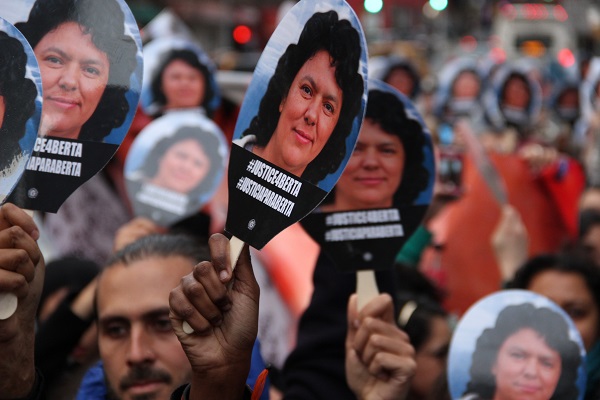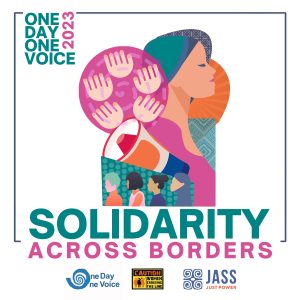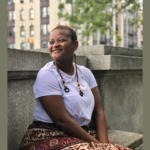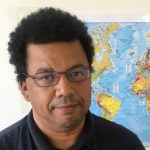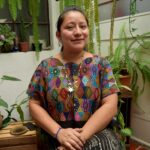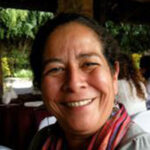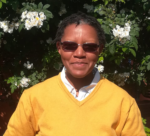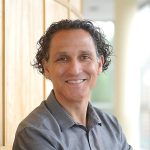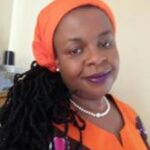One year ago, Honduras became headline news with the assassination of Berta Caceres. A distinguished indigenous leader, feminist, environmental defender and recipient of the 2015 Goldman Environmental Prize, Berta was killed for organizing opposition to a hydroelectric dam on the Agua Zarca River in Lenca territory. In the days following her murder, hundreds of organizations and thousands of people worldwide mobilized a sustained outcry for justice in support for her organization, COPINH, and her family. My organization (JASS) and I were involved from the beginning and I can honestly say that in three decades of activism, I’ve never witnessed an instantaneous mobilization of that scale, diversity and impact.
Berta touched many people through her smart, openhearted political work, including her adversaries in the US State Department and World Bank. She worked with dozens of organizations, social movements and activists across the globe.
We worked closely with Berta and her loss felt deeply personal. As a gravitational force, Berta powered all of us. Collective outrage and political love seemed to connect people, institutions and issues that don’t easily mix and match, opening many doors and igniting political momentum. Environmentalists, journalists, feminists, priests and nuns, indigenous peoples, government officials, investors, racial justice activists and donors joined forces, putting aside affiliations and identities to get things done.
 Her assassination took place just before the UN Commission on the Status of Women (a global gathering of government and civil society representatives due to take place again this month). Overnight JASS joined with others to organize a Honduran women’s delegation to New York – led by one of Berta’s extraordinary daughters, Bertita Zuniga – to use the spotlight of the Commission to call for global solidarity and frame the agenda. The passion and natural leadership of my young Honduran sisters mixed with the outpouring of support, resources, expertise and access garnered prime-time visibility and influence over five, hectic, 11-hour days.
Her assassination took place just before the UN Commission on the Status of Women (a global gathering of government and civil society representatives due to take place again this month). Overnight JASS joined with others to organize a Honduran women’s delegation to New York – led by one of Berta’s extraordinary daughters, Bertita Zuniga – to use the spotlight of the Commission to call for global solidarity and frame the agenda. The passion and natural leadership of my young Honduran sisters mixed with the outpouring of support, resources, expertise and access garnered prime-time visibility and influence over five, hectic, 11-hour days.
I remember vividly a rally in the rain on 1st Avenue; a wet crowd stretched down the block, holding paddles with Berta’s face printed on them and listening to Bertita and an Irish nun from the Sisters of Mercy, their fiery words interspersed with drumbeats and chants from a group of Filipinos from Mindanao who face a similar fight.
Then, I remember that we were gathered across the street from the Trump Tower.
What a difference a year makes. To one Honduran colleague, today’s US politics resemble Honduras’s “soft coup” in 2009, which created the crises and violence they currently face: “Welcome to Honduras,” she tells me. The parallels between Standing Rock and the Lenca resistance are too many to name.
Over the last year, attacks have escalated against COPINH and other communities across Honduras that are defending land and resources against corrupt business deals and land grabs. Journalists, feminists and LGBT activists – among other dissenters and democracy defenders – have been killed, sued and slandered, while the government shrinks freedom of expression and expands the definition of terrorism.
A dispiriting scenario, at least from afar. But look closer. The gains achieved by this scrappy mix of movement-led grassroots organizing, global solidarity and smart advocacy are pretty impressive: the Dutch and Finish investors (FMO and FinnFund) in the dam project are pulling out; eight men have been charged with Berta’s murder and taken into custody; an independent international commission has been formed to investigate the crime; the US House of Representatives has introduced the Berta Caceres Human Rights in Honduras Act to suspend US military aid; and this story remains headline news from the The Economist to the The Guardian as journalists and analysts connect the dots of corruption and violence between government, business interests and US military aid.
Of course, uncertainties about these gains are many and significant. The situation is volatile. As we say in JASS, “Change is physics: plan for reaction and conflict.” Honduran justice activists of all stripes know that power will attempt to reverse, derail or delegitimize these gains and the people behind them, sometimes violently.
One year on, then, what can we learn from Hondurans about what has mattered most in the efforts to organize, resist, and sustain #justice4berta? Here as some insights garnered from JASS conversations with five prominent Honduran leaders on the frontlines of this effort.
1. Nature, humanity and the future are a worldview not a single issue
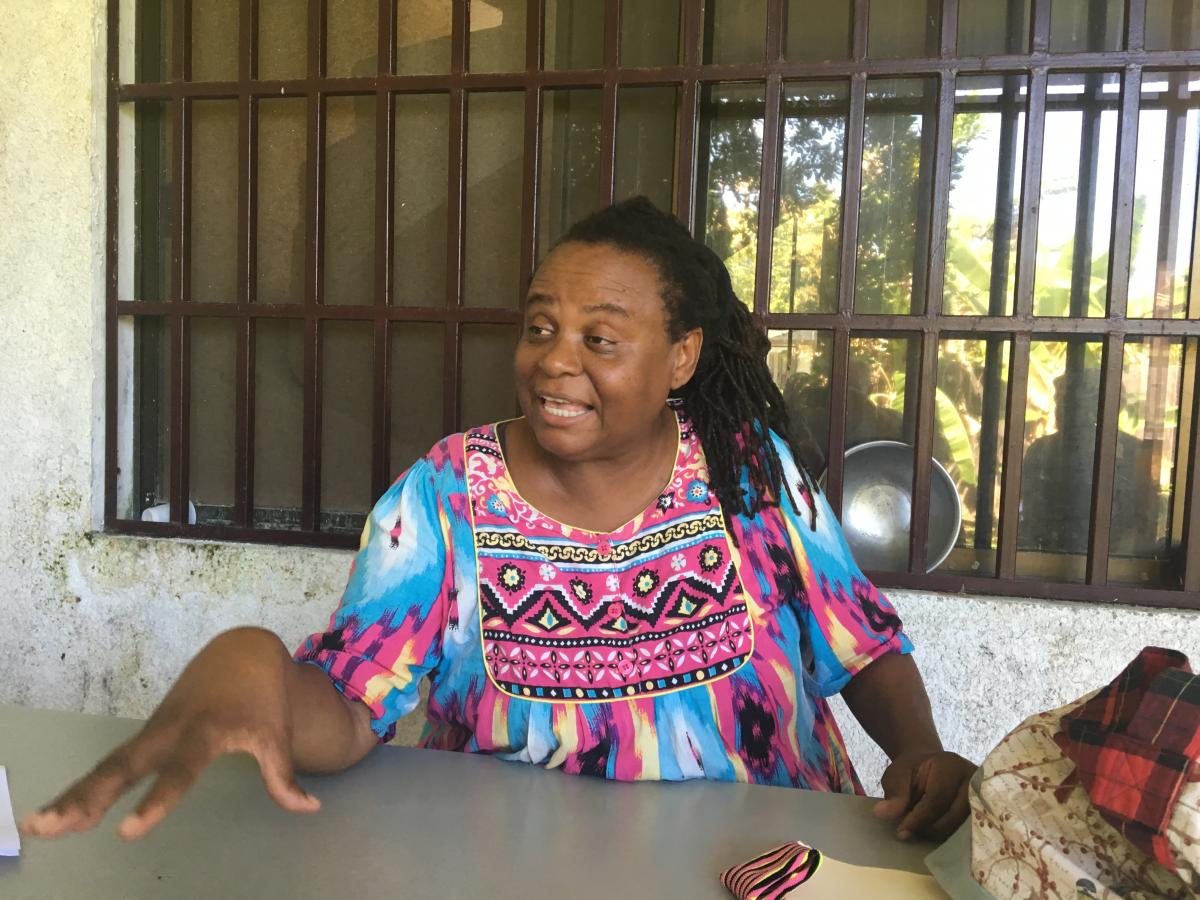 When Berta accepted the Goldman prize, she explained from the stage: “The Lenca people are ancestral guardians of the rivers. Protecting rivers means giving our lives for the wellbeing of humanity and of this planet.” The river is not an issue, it’s part of a philosophy of life that Berta invited all of us to share. Berta saw no separation between economic, environmental and identity issues. The worldview is critical to sustaining this effort. Tomas Membreno, COPINH Coordinator, says, “Our cosmovision is what brings us all together. It gives us strength, it guides our choices and it permits us to draw on the wisdom of our ancestors.” Miriam Miranda, Coordinator of OFRANEH – an organization of and for the Garifuna people – and a close friend of Berta’s, believes this worldview helps educate and awaken people: “we have contributed to the growing global consciousness about the urgent need to defend nature as a common good.”
When Berta accepted the Goldman prize, she explained from the stage: “The Lenca people are ancestral guardians of the rivers. Protecting rivers means giving our lives for the wellbeing of humanity and of this planet.” The river is not an issue, it’s part of a philosophy of life that Berta invited all of us to share. Berta saw no separation between economic, environmental and identity issues. The worldview is critical to sustaining this effort. Tomas Membreno, COPINH Coordinator, says, “Our cosmovision is what brings us all together. It gives us strength, it guides our choices and it permits us to draw on the wisdom of our ancestors.” Miriam Miranda, Coordinator of OFRANEH – an organization of and for the Garifuna people – and a close friend of Berta’s, believes this worldview helps educate and awaken people: “we have contributed to the growing global consciousness about the urgent need to defend nature as a common good.”
2. Shared political analysis builds organization and guides strategy
Translating a worldview into action requires “integrated thinking” (Bertita) or political-economic analysis to inform goals and strategy: it is important to “be clear that the enemy is the capitalist, racist and patriarchal system that’s driven by dispossession,” (Tomas). But “integrated thinking” and power analysis demand time, space and structured dialogues to “build trust and a common ethic, clarity of common thinking, respect for differences, and a level of transparency. … Coherence among activists and organizations operating in adverse and different contexts allows us to respond quickly,” (Gilda Rivera, Director of the Center for Women’s Rights).
3. Concrete demands keep everyone’s eyes on the prize
“A clear set of demands developed by COPINH and our allies allows us to channel all the solidarity in support of this struggle toward one goal,” (Bertita). These leaders agree that concrete demands offer solutions and respond to the problems felt by communities, giving everyone a measure against which to gauge their organizing and enable advocates in other parts of the world to remain aligned with COPINH and Hondurans. For example, COPINH and allies called for the cancellation of the dam project and withdrawal of investors, and this clarity guided Dutch and Finish advocates in their direct engagement with the investors.
4. Narratives are a primary battleground
“Today, the world knows what’s happening in Honduras; that the coup in 2009 devastated life here; that Honduras is a dictatorship where the institutions of the state are collapsing, that the violence and criminalization of defenders is on the rise and that communities are in full resistance,” (Miriam) When Berta was killed, “the government and the local media spoke about it as a ‘crime of passion’ or an internal dispute within COPINH.” (Tomas) The movement worked intensively to recast events. “We shifted the narrative from a crime of passion to a crime of the state and that’s how we shaped our demands and the strategy. We also exposed the role of the investors and the myths of “green” energy by showing the real costs to people and communities.” (Bertita)
Quality headlines are not just about narratives – they require a media advocacy that relies on a network of allies. “Solidarity at national and international levels helped us break through the tight media circles.” (Tomas) This combined with credible research like that of Global Witness have framed and substantiated what’s happening in Honduras for maximum media reach.
5. Community organizing and women are key to resistance and resilience
Tomas describes COPINH as a “school that’s permanently under construction.” The process of training and education “is the reason why our capacity to mobilize and our conviction is so strong” in the face of violence. Lilian Lopez, who co-leads COPINH’s women’s leadership program, says “the struggle is waged within and outside” because COPINH helps women and men “challenge patriarchy” and develops women’s roles within the organization. These activists recognize the critical role women play in holding communities together and in many other ways. For Lilian, organizing involves “knowing what’s happening in communities and the struggles they are having. We make sure we’re all in touch with each other and continuing to build our unity.” Organizing is crucial to survival. Some weeks back Miriam put it this way, “we should recognize the protecting force that comes from our ancestors and learning spaces.’
6. Living with fear
“It’s important to recognize that we’re human, we’re afraid. Afraid of what might happen, of the repression, of the assassinations, of the violence. But it doesn’t paralyze us. It motivates and connects us to keep going“ (Gilda). Fear is ever-present for these leaders, their communities and organizations. It’s something they name, embrace and resist everyday. My colleague at JASS, Daysi Flores, put it in words when she said, “I’m more afraid of remaining silent than I am of speaking out.”
Perhaps this is one of many reasons that music, dance, and ritual are so vital to this movement. They believe that creating and feeling joy is as important to movement-building and sustaining resistance as any strategy. . After all, Berta told us: “The right to be happy is very subversive. For this reason, we should aspire to be happy.”
This article was originally published on openDemocracy, March 3, 2017.
Photo 1: New York Rally, March 2016. Credit: Natalie Jeffers, Matters of the Earth.
Photo 2: Bertita Zuniga, Honduras. Credit: Daysi Flores
Photo 3: Miriam Miranda, Honduras. Credit: Patricia Ahern

